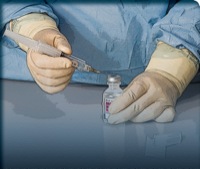Unfortunately, the number of hospitals that have done so is meager, said Eric Kastango, RPh, MBA, FASHP, a compounding quality expert who is the president and CEO of Clinical IQ. In the harsh light of the fungal meningitis crisis, he said, he would have anticipated that hospital pharmacies “would be more concerned about their state of compliance relative to USP <797>.” But Mr. Kastango said the general attitude had been, “‘I really don’t have to worry because this is just about compounding pharmacies and not hospital pharmacies.’ There’s not an overarching sense of urgency in the hospital segment.”
That has to change, Mr. Kastango said. “Based on the consulting that I do,” he said, “even people who are doing a good job have significant gaps in compliance that can have a [major] impact on the quality of medications they’re making for their patients.” An Institute for Safe Medication Practices survey earlier this year supports Mr. Kastango’s contention that hospital pharmacies are lagging (Pharmacy Practice News 2013;40:1, 29-32; bit.ly/1bWXmjI). The survey showed that three of four (74%) respondents felt contamination could be a risk for their facilities, and 13% said contamination actually had occurred during the past year.

Cedairs-Sinai Initiative
Cedars-Sinai Medical Center, in Los Angeles, has taken these compounding risks to heart. The hospital has carried out a major reevaluation and revision of its sterile compounding quality plan, according to Rita Shane, PharmD, FASHP, the director of pharmacy services at the center. Dr. Shane said the review was prompted not only by the desire to update and improve the pharmacy’s long-serving compounding quality assurance plan but also by new California compounding safety rules, considered to be among the nation’s strictest.
The initiative was launched several months before the meningitis crisis erupted last September, said Katherine Palmer, PharmD, the sterile products area supervisor at Cedars-Sinai, but its timing seemed to grow in importance as more and more infections and deaths from injections of contaminated methylprednisolone distributed by the New England Compounding Center (NECC) were reported. “Compounding is on everyone’s radar right now,” said Dr. Shane, who with Dr. Palmer and pharmacy manager Bruce Vinson, PharmD, reported on Cedars-Sinai’s revised quality assurance plan at the June 2013 Medication Safety Collaborative meeting, held in conjunction with the American Society of Health-System Pharmacists Summer Meeting.

One new innovation in the medical center’s plan is an online dashboard, an easy-to-grasp Excel tool that helps pharmacy monitor and report progress in meeting USP Chapter <797> goals as well as state requirements for environmental control, personnel performance, medication storage and other factors. The dashboard, Dr. Shane said, “serves as a kind of tickler or prompt to make sure that everything is being evaluated on a timely basis.”
Before the dashboard was introduced, compounding activities were monitored and documented in an assortment of notebooks, Dr. Shane said. Now, with the template in place, the new system “has enabled us to organize our quality assurance activities and include the frequency for each component to facilitate tracking of our monitoring [efforts].”
All of the components of the dashboard are essentially in compliance with USP Chapter <797> standards, Dr. Shane said, but a few specifically address California rules, such as the need to validate the time spent observing staff prepare sterile medications. “This is USP <797> plus,” she said.
Are Hospitals Ready For Random Inspections?
California hospital pharmacies now are required to file self-assessment reports on compounding quality only every two years. But Dr. Shane said that she expected the California board to add hospital pharmacies to the list of random inspection sites. She said that a state inspector who was evaluating a new Cedars-Sinai outpatient cancer center last fall took a look at the pharmacy’s revised compounding quality plan and “felt that it did support what they expected organizations to be doing.”
The Cedars-Sinai pharmacy staff is not standing still when it comes to improving compounding quality. They are anticipating the imminent arrival of a new microbial air sampler, a much more efficient and accurate tool than the agar paddles now in use. The new device will allow pharmacy to measure the biological burden around hoods and clean rooms more frequently than the twice-yearly intervals recommended by USP Chapter <797>. “The machine will enable us to simulate what the certifiers are able to test when they’re here,” Dr. Palmer said.
What lessons can other hospital pharmacies take from the fungal meningitis crisis? Mr. Kastango said, “They need to understand that the events that happened at NECC can happen in their pharmacies, and they need to be vigilant,” even if they are not required to be inspected under federal or state rules. “From a strategic and tactical position,” he added, “people need to get their house in order and understand where they are relative to compliance with <797>. The chapter has been out for nine years now, and this stuff matters.”
http://www.pharmacypracticenews.com/ViewArticle.aspx?d=Policy&d_id=51&i=September+2013&i_id=992&a_id=23961&tab=MostRead
No comments:
Post a Comment